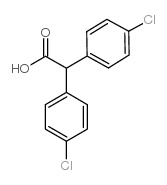2,2-bis(4-Chlorophenyl)acetic acid (DDA), a water-soluble urine biomarker of DDT metabolism in humans.
Zhenshan Chen, Francois Maartens, Helen Vega, Simon Kunene, Jonathan Gumede, Robert I Krieger
Index: Int. J. Toxicol. 28(6) , 528-33, (2009)
Full Text: HTML
Abstract
DDT metabolism in humans yields DDA as the principal urinary metabolite and potential exposure biomarker. A method for DDA analysis in human urine was developed using pentafluorobenzyl bromide and diisopropylethyl amine. Dried hexane extracts were reacted for 1 hour at room temperature. The stable DDA-pentafluorobenzyl-ester derivative was analyzed by gas chromatography-electron capture detector (GC-ECD) and confirmed by gas chromatography-mass spectrometry (GC-MS) in selective ion monitoring mode. The limit of detection for DDA was 0.1 microg/L urine by GC-ECD and 2 microg/L urine by GC-MS, with a relative standard deviation of 12%. Urine specimens from DDT applicators in Swaziland and South Africa were analyzed to evaluate the method. The mean DDA levels during the spray season and post season were 59 and 11 microg/L, respectively. These results must be interpreted cautiously because different groups of workers provided urine specimens in each case. The DDA urinalysis may be a feasible monitoring strategy for low-level occupational and residential DDT exposure assessment in antimalaria campaigns.
Related Compounds
| Structure | Name/CAS No. | Molecular Formula | Articles |
|---|---|---|---|
 |
4,4'-DDA
CAS:83-05-6 |
C14H10Cl2O2 |
|
Mitotane (1-(o-chlorophenyl)-1-(p-chlorophenyl)-2,2-dichloro...
1987-01-01 [Drug Metab. Dispos. 15(2) , 267-9, (1987)] |
|
Oxidation at C-1 controls the cytotoxicity of 1,1-dichloro-2...
1995-05-01 [Drug Metab. Dispos. 23(5) , 595-9, (1995)] |
|
Development of an enzyme-linked immunosorbent assay for the ...
1987-05-01 [Bull. Environ. Contam. Toxicol. 38(5) , 798-804, (1987)] |
|
[The enzymatic degradation of DDT. 6. The fate of the DDT me...
1987-01-01 [Nahrung 31(3) , 253-7, (1987)] |
|
Interaction of structurally similar pesticides with organic ...
1993-08-01 [J. Pharmacol. Exp. Ther. 266(2) , 673-7, (1993)] |